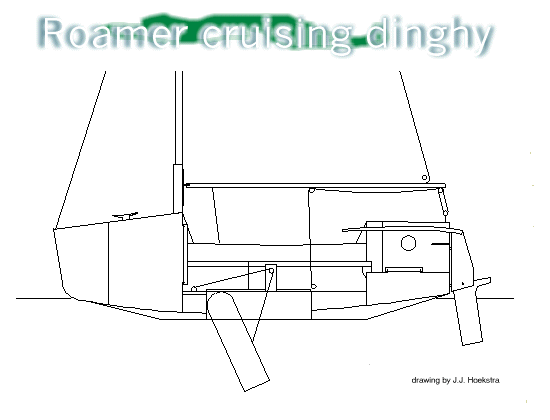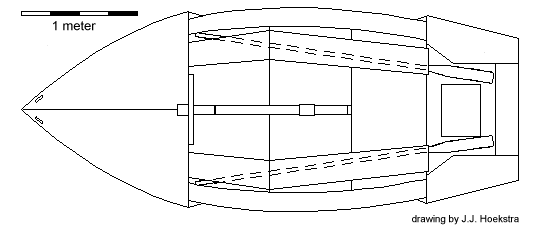

There is nothing special about why we choose to build a Roamer rather than buy one of the better known small boats like the Wayfarer, the West Wight Potter or the Drascombe Lugger. We had read two articles in PBO on the Roamer in which this design was described as a small sturdy boat, with good sailing qualities, light on the helm and forgiving of helmsman errors. It also explained that this boat was difficult to capsize due to the very foredeck and "side-castles" on the back. Together the give high leverage in case of a capsize. We wanted to build rather than buy and the plans showed that the design of the Roamer was geared towards amateur completion. We has never build a boat before so this was encouraging, we had three weeks holiday, the money and we had a project-plan which proved that it would be possible to build the boat in those three weeks. Obviously we did not manage to build it that quickly, but we came close and most of the delays were related to us finishing the boat to a higher standard than originally planned. Instead of no-name waterproof ply we had the unexpected luck of getting Bruynzeel Suprahecht Mahogany ply instead. This was such a beautiful wood that we decided to leave large parts of the wood visible rather than painting it. This required a far better finish and thus more work.

While building our boat, we freely adapted the original design. The only thing we didn't change were the dimensions. There were several reasons for these changes: to speed up building, to make the boat easier to maintain or because specified woods were unattainable. For instance for the centerplate-casing mahogany boards where specified. We thought that building this with mahogany ply and epoxy would be stronger and cheaper.
Building yourself gives a great opportunity to change the details
of a boat to your own wishes. This makes it possible to adapt
an existing design to specific wishes. More storage space, or
build-in buoyancy are examples of changes to a design which are
easily done. Changing a design is also a great way to learn. Nothing
is a better learning experience than having to make something
twice because the first time you changed to original design into
something which didn't work as you hoped. But hey, "No pain,
no gain"!
| designed by | E.G. Coleman |
| date designed | 1970 |
| purpose | cruising, including cruising at sea |
| crew | 1 or 2 |
| length | 4.3 m |
| width | 1.76 m |
| depth | 30 cm center-plate up, 103 cm center-plate down |
| weight | 260 kg |
| ballast | 72 kg lead inboard |
| height | 6.1 m above water |
| building materials | Epoxy and glass from Polyservice
Plywood: 7 and 18 mm Bruynzeel Suprahecht Other woods used: red cedar and white oak. |
| center-plate | 110x30 cm, 3 layers of 8mm mahogany ply reinforced with 3x300 g/m2 glass, ballast: 4 kg lead. |
| storage space
| 4 wet area's under floor boards, 80 l each 2 watertight sections in "side castles", 60 l each 1 watertight compartment in front-section, 700 l 1 watertight section under afterdeck, 220 l |
| self-flotation | 180 l PU foam in peek 160 l PU foam below floorboards 4 watertight compartments |
| mast | epoxy/glass around foam core, 5.4 m long, floating. Mast stands in tabernacle. The tabernacle and mast are strong enough to withstand sailing without standing rigging. The stays only prevent the mast from bending too much and so keep the sail from sagging. |
| standing rigging | 4 mm Dyneema, no spreaders |
| sails | Jib: 2.8 m2, 4 oz cloth, 1 row of reefing points
Main-sail: 6.9 m2, 5 oz cloth, 2 rows of reefing points |
This page last update 06oct96 and located at: GeoCities